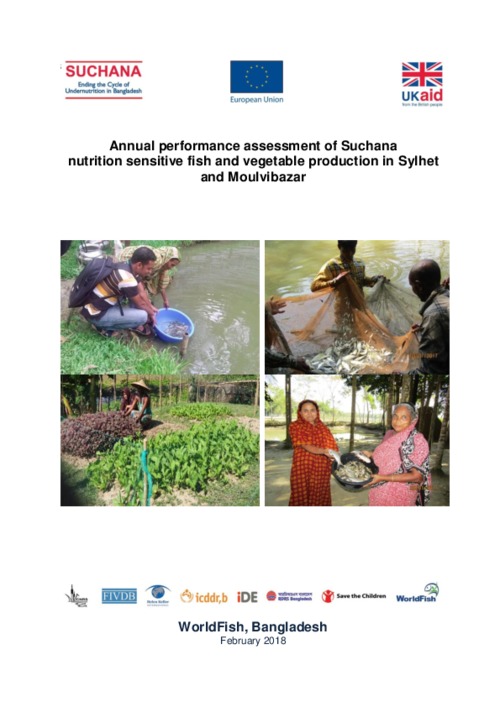Annual performance assessment of Suchana nutrition sensitive fish and vegetable production at learning phase in Sylhet and Moulvibazar

Citation
Baten, Md A. et al. (2018). Annual performance assessment of Suchana nutrition sensitive fish and vegetable production at learning phase in Sylhet and Moulvibazar. Penang, Malaysia: WorldFish. Report.
WorldFish is promoting nutrition-sensitive fish and vegetable production systems for beneficiary households in north-east Bangladesh as part of the ‘Suchana’ consortium led by Save the Children and other consortium partners; HKI, IDE, icddr,b, CNRS, FIVDB and RDRS. The goal of the 6-year program is to reduce childhood stunting by additional 6% in 250,000 very poor households in Sylhet and Moulvibazar districts within first 3 years of interventions. It was anticipated that 30% of the beneficiary households would have access to ponds or other small water-bodies and they would receive support on nutrition-sensitive fish production along with other nutrition-sensitive and nutrition-specific program components. Nutrition-sensitive fish and vegetable production interventions focused mainly on carp and tilapia polyculture along with the production of small indigenous fish species along and different types of vegetables. The main aim of the interventions was to increase the production and consumption of fish and vegetables to enhance dietary diversity of women and young children (6-23 months). Before initiating large-scale implementation, a learning phase was implemented in 2016 targeting 14,714 beneficiary households (BHHs) from the 12 unions in Sylhet and Moulvibazar. During this period, WorldFish supported 6,610 beneficiary households (BHHs) and 103 demonstration ponds. All BHHs received nutrition sensitive horticulture related interventions, and 5,109 BHHs and 103 Demo Pond owners also received nutrition sensitive aquaculture support. There was strong adoption of the technologies with 90% of BHHs harvesting fish and 98% harvesting vegetables over the following year. More than 80% of the fish and 76% of vegetables were consumed by household members including women of reproductive age and young children. Participation of women in aquaculture and horticulture activities increased as well. In the BHHs, more than three-fifth of the women (59%) and two-third of the young children (64%) consumed diversified diets at the annual assessment and that was only 25% for the women and 20% at the formative research. These two findings weren’t directly comparable methodologically but still we may use as the reference points to get the ideas before starting the Suchana interventions. Moreover, fish was consumed on a regular basis by 91% of women compared to 51% of young children at the annual assessment indicating that more attention should be given to the promotion of feeding fish to young children. The major challenges expressed by BHHs were joint ownership of ponds, highly turbid water during rains, and lack of technical knowledge and experience while flooding and drought also affected vegetable production. Many subjects also wanted Suchana to provide better quality fish seed, continued training and technical support. While the project provided fish and vegetable seed along with other key inputs, it is important that these are made available at the right times of the year.
Permalink
Date Available
Type
Publisher
Countries
Copyright
CC-BY-NC-4.0
Research Themes
Language